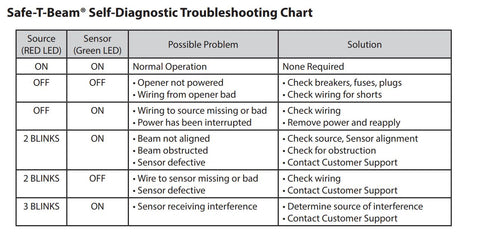Published on: November 16, 2021
Garage door accidents account for 20,000 to 30,000 injuries every year. The garage door can be the most dangerous area of the house since it can easily weigh over 100 pounds. Several dozen deaths every year are linked to garage door incidents. Many victims are small children. There are many safety precautions that can be taken to reduce the risk of a garage door accidents or injury related to the garage.
Tip #1: Check Garage Door Opener’s Safe-T-Beams
Safe-T-Beams ensure maximum safety while operating your garage door opener. Genie Safe-T-Beams use an invisible infrared beam across the opening of the door. If the system detects a small child running through the beam, the garage door will automatically reverse open. Safe-T-Beams are self-diagnostic, meaning the lights found on the Safe-T-Beams will alert you of a malfunction (see chart below). A properly working Safe-T-Beams pair should have one red solid LED and one solid green LED. Make sure the lenses are clean and wipe with a cloth. Learn more about Safe-T-Beams here.

Tip #2: Test the Reverse Safety System
According to the National Electronic Injury Surveillance System, an average of 2,000 people are crushed by garage doors each year, many of which are children. The contact reverse system built into your Genie garage door opener automatically reverses a closing door when an obstruction has occurred. This is done by placing a 2” x 4” board in the center of the garage door opening and making sure the garage door reopens when the door begins closing and hits the board. This ensures if any child is sitting or positioned under the garage door, the door will reverse if the door hits the child. The non-contact reversal test can be performed by rolling a ball through the garage door while it is closing to make sure the door reverses. Detailed steps to perform these tests can be found here.
Tip #3: Make Sure Remotes/Wall Consoles are Out of Reach
Children can view a garage door opener remote as a toy. Children enjoy pressing buttons and may find it fun to watch the garage door go up and down. Allow children to open the door as you pull into the garage and close the door, but do not leave any remotes unattended. A child could open the garage door without your knowledge and wander out to the street, a potentially dangerous situation.
The push button or wall control should be out of reach of children (at least 5 feet from the floor) and away from all moving parts. Mount and use the button where you can clearly see the moving garage door.
Tip #4: Regular Garage Door Opener Maintenance
Most garage door openers operate for 10-15 years before a replacement is needed. Completing routine preventative maintenance on your garage door opener will help to extend your opener’s life and ensure a safe operation.
|
Maintenance Item |
Interval |
Details |
|
Contact Reverse Test |
Monthly |
|
|
Lubricate Door Hardware |
Monthly |
Lubricate rollers and hinges with light-weight general purpose grease. |
|
Safe-T-Beam system check |
Monthly |
Check wiring for loose connections, cracks, or worn insulation. Clean lenses of dirt & debris. |
|
Door Balance |
Monthly |
|
|
Battery Backup System |
Monthly |
Unplug opener from outlet. Test opener with remote or wall console. Replace battery if needed. |
|
Chain/Belt Adjustments |
Yearly |
Inspect chain/belt for excessive slack, adjust as necessary. |
|
Remote Battery Replacement |
As Needed |
Most Genie remotes use a CR2032 battery. |
|
Light Bulb Replacement |
As Needed |
Tip #5: Lock Any Space a Child Could Hide
Secure areas where small children might choose to crawl into and hide. This could include locking your car or a cabinet in the garage.
Tip #6: Keep Dangerous Items Out of Reach or Locked
Secure bicycles, power tools, chemicals, and toxic liquids out of reach or in a locked container. This includes lawn chemicals, gasoline, cleaning solutions, antifreeze, pest control poisons, paint, and motor oil. Make sure there are no buckets full of liquid within reach as children are able to drown in as little as 1” of water. Do not store chemicals in plastic milk jugs or juice containers. Children may attempt to drink these items. Chemicals can also eat through certain types of plastic and create a dangerous leak.
Tip #7: Always Supervise Young Children
Last but not least, and the most common-sense tip of all is to supervise young children when they are accessing the garage. The best safety net is a trusted adult watching and monitoring children’s activities, especially when in a garage.
image: pexels


